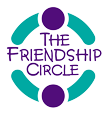The Friendship Circle Story
Friendship Circle of Pittsburgh began in 2006 by Rabbi Mordy and Rivkee Rudloph
through the inspiration of Rabbi Menachem Mendel Schneerson, the Lubavitcher Rebbe, of
righteous memory. The essence of his eloquent call for inclusion was that each person has
great value and that the rest of society is incomplete without their inclusion. As a result,
Friendship Circles were established throughout the world and each developed differently
under their own leadership. Now in our fourteenth year of operation, the Friendship Circle
of Pittsburgh offers over 150 programs per year, engages approximately 550 people from
around the greater Pittsburgh area and serves as a catalyst for community inclusion and
social change.
Core Foundation
Rabbi Mordy and Rivkee Rudolph began with a desire to help remedy one of the most
painful aspects of living with a disability, namely, social exclusion and isolation. They
understood that opportunities for friendship were both invaluable and rare. As David
Pitonyak wrote so clearly , “disability is the only real disability.”
They developed the core of Friendship Circle of Pittsburgh which provided a place that
welcomed and valued the uniqueness of each member and provided opportunities for fun,
friendship and opportunities to contribute their abilities to make FC of Pittsburgh even
stronger. For members with disabilities , it has always been a place where they can be fully
themselves without the need to change in any ways;
We made an intentional decision not to be another “therapeutic “ program in their lives.
This was guided by the firm belief that it is the opportunities that need to change, not the
members. Rather, we concentrated on opportunities for friendship and connection and
encouraging members to use their own talents in a variety of ways. This has continued as
the core of all activities to this day.
Expanded Mission
The second chapter of the story of Friendship Circle of Pittsburgh grew out of a
recognition that the better way to address the problem of social exclusion was to build a
community that did not have divisions between people with and without disabilities. We
understood that the best way to diminish social barriers is for people with and without
disabilities to work and play alongside each other. This meant that it was time to no longer
categorize people as “alternately “ volunteers or “friends”. We all became one cohesive
group without distinctions; we were all designated as members who also volunteer their
talents and efforts as desired. This shift surprised some people because it was a model
unlike all other programs that traditionally match members with volunteer “buddies”.
As part of this important evolution, FC of Pittsburgh embraced the motto that has long
been important within disability rights movements ”nothing about us without us.”
All facets of leadership in programing now include members with a range of disabilities
and the supports (if needed) to make them effective. This is evident throughout FC
including in the Teen Leadership Board, the host committees for all programs, and the
Friends on the Town Leadership Council.
In keeping with a recognition that social barriers are the major reason why people with
disabilities are often excluded from the mainstream of life, Friendship Circle of Pittsburgh
revised its mission to emphasize community inclusion. The pathways FC of Pittsburgh has
been taking to achieve this mission have multiplied. They include training tracks for all
members to learn from local leaders about the history of discrimination and the value of an
inclusive society. The teen leadership board has come to understand that it was not
enough to create a separate place where everyone is welcomed and valued and they
embraced the promise advocacy holds to change communities. This led to community
partnerships as well as establishing inclusion clubs in many schools.
Belonging and connecting continue to be our bywords. They guided the development of
our first pop up bakery venture during which members were paid and worked alongside
community members to produce the best ever cookies and other treats that were eagerly
bought by the larger community. This year, we have also been happy to connect our first
member with a community job and we are looking forward to many more such connections.
The story of the Friendship Circle of Pittsburgh continues with the pandemic. We understood the
importance of having the FC stay connected-especially since the natural social networks of
many members are disproportionately limited. Without missing a beat, we were able to
connect more than 250 members during the pandemic stay at home orders.
An inclusive community is one in which every member is valued and an intrinsic part of
that community. That is what we have developed at Friendship Circle and that is what we work
towards in the greater community.
